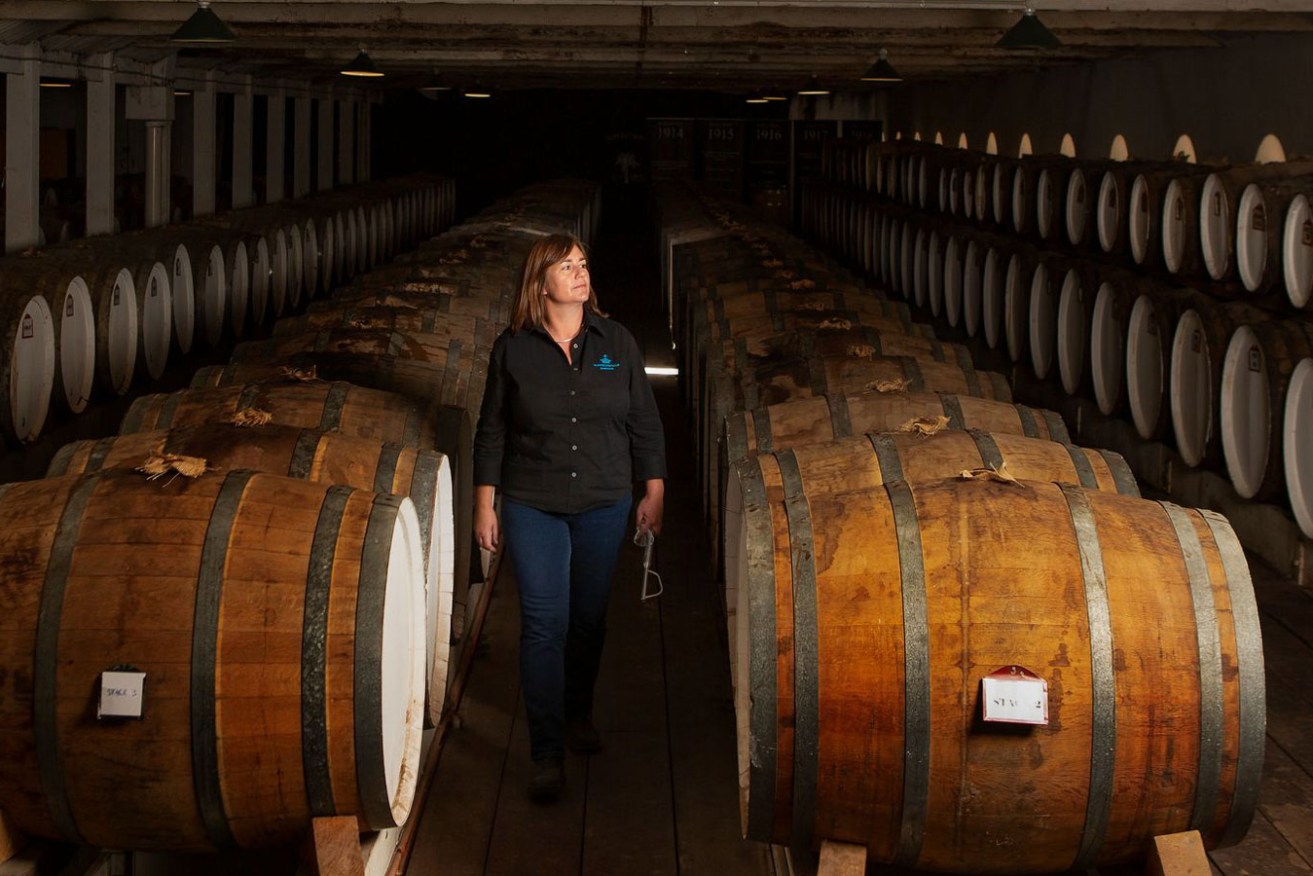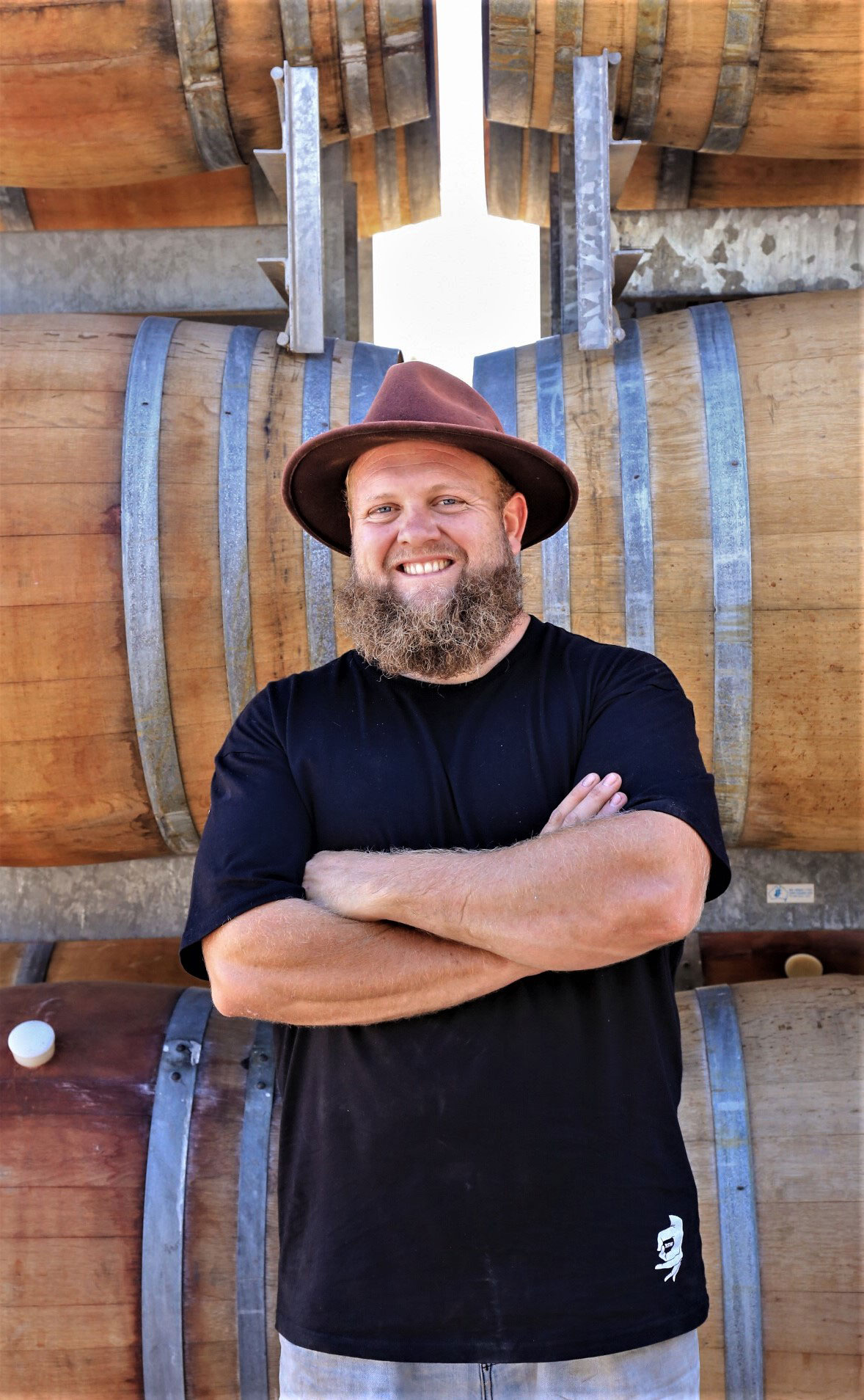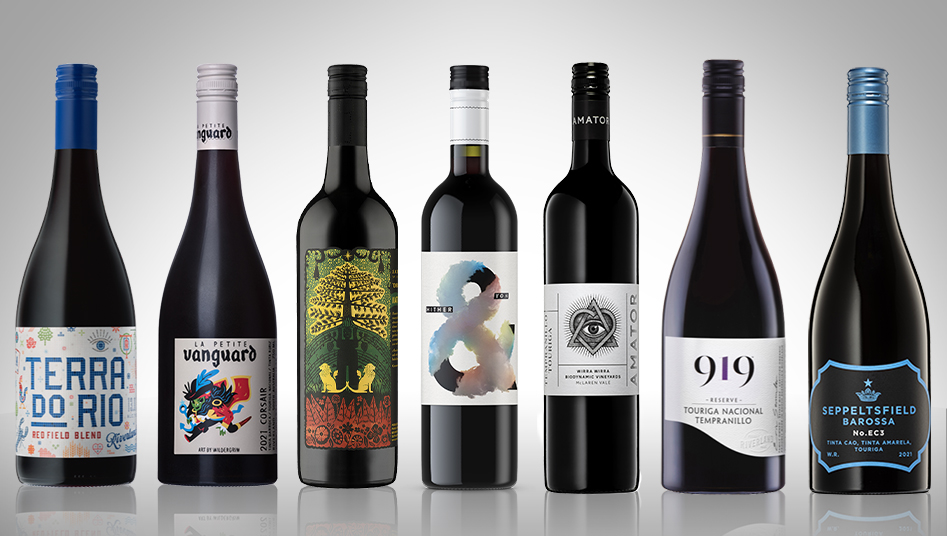Wine reviews: The climate is right for these cool reds
Many ‘alternative’ varieties that were once the backbone of Australia’s famed fortifieds are now resurfacing in a new guise.


Seppeltsfield chief winemaker Fiona Donald in the winery's Centennial Cellar.
In the era of what we have simplistically called “alternative” or “emerging” varieties, we’ve also gone down another convenient path of lumping most of them together in a vague geographic pot as being of “Mediterranean” origin.
But there is more to the story. Sure, many of the southern Italian, French and Spanish grapes fit nicely into that box, but there are others from more northerly regions of those countries that are influenced by other continental and oceanic factors.
Time to get out your maps of Europe and look up the Iberian Peninsula abutting the Atlantic Ocean, taking in Spain and Portugal, both of which have a vast range of their own indigenous grape varieties. In the case of the latter country, many of the reds have been integral to the making of Port – which traditionally has been a blend of several varieties with names we should start getting our tongues around here in South Australia.
Names such as Touriga Nacional, Tinta Cao, Tinta Barocca, Tinta Amarela, Souzao, and Tinta Roriz (which also is known as Tempranillo, most commonly associated with the Spanish regions Rioja and Ribera del Duero), have all been part of our rich history of fortified wines. But as that has waned over the past few decades we are seeing those varieties appearing in a new wave of table wines that suit the way our drinking tastes are evolving and, equally importantly, they are climatically adjusted and very happy growing here in our warm to hot and dry summers.
The most powerful example of this transition comes from Seppeltsfield, whose fortified wine reputation needs no introduction. The company is renowned for its 100 Year Old Para Tawny program, and has up until recently also made Vintage Port styles. But VP is no longer in its system, and the grapes from an established grower vineyard in the Barossa’s Stonewell district that went to the VPs have reappeared in a terrific table wine, a blend of Tinta Cao, Tinta Amarela and Touriga Nacional with the complicated nomenclature No. EC3, which refers to an old cellar numbering system.
It’s not the only historic reference point for Seppeltsfield chief winemaker Fiona Donald as she guides these traditional Port varieties into a new chapter.
“We understand our grape resource, and the connection between our vast fortified history and pulling that through to our table wine efforts,” Donald says.
“Reinterpreting the traditional fortified varieties such as the Tinta and the Touriga, even Grenache and Mataro, and also drawing on the long history of the Tawnies and our house style – medium weight, aromatic and fresh – we have taken a lot of those cues and applied them to our table wines.
“We’re not aiming to make broad-shouldered, mega-robust wines. We’re aiming to medium-weight, balanced, fresh and contemporary wines.”
Another winemaker in the crossover zone is Riverland based Eric Semmler of 919 Wines, a renowned fortified maker for many years who also has a steady foot placed in the table-wine camp with a couple of variations: a Touriga Nacional/Tempranillo blend, which also gets a tiny splash of Tinta Cao for its aromatic floral characters, and also a straight Touriga, which this week was named the best organic wine in the annual Winestate awards.
All those varieties still go into the 919 Wines fortified system as well, while they are garnering a growing fan base as table wines proudly grown and made in the Riverland.
“The T&T has an elegance and finesse of Portuguese blends and helps people to find that attractive,” Semmler says.
Both varieties are suited to the Riverland’s hotter growing season climate, he adds.
Eric and wife Jenny visited Portugal more than a decade ago and were impressed by the producers in the Douro Valley who were making table wines.
“It was an inspiration to us,” Semmler recalls. “They have a very similar climate to us – hot and dry through the summer – and we thought it would make good sense to plant some of those varieties in the Riverland.”

Winemaker Michael Corbett.
Since then, several other producers in the region have gone down the same path. Salena Estate has its own robust styles of Touriga inclusive blends, while Ashley Ratcliff has dedicated a vineyard in Barmera to many Portuguese varieties. Ratcliff’s vineyard is a source block for winemakers in and outside the region (such as Prometheus Wines), as well as for his own Ricca Terra and Terra do Rio range, which includes a red field blend of Souzao, Tinta Cao and Touriga Nacional, as well as a straight Touriga.
Bruce and Val Bassham also have a swag of alternative varieties on their vineyards, many from the Iberian catalogue such as reds Prieto Picudo and Mencia, as well as Tinta Barocca and Touriga. Whites include Fernao Pires, Arinto and Verdejo.
Progressive winemaker Michael Corbett, with his Vanguardist and Le Petit Vanguard labels, taps into both the Semmlers’ and the Basshams’ vineyards for his delightful Corsair, a blend of Tinta Barocca, Touriga Nacional and Tinta Roriz (Tempranillo).
Having had no experience of the varieties or the Riverland before exploring there in early 2020, Corbett realises now that he can make generous styles from these varieties that still offer a lot of drinking pleasure as young wines.
“It’s probably not the easiest thing to achieve with those varieties,” he says.
“I’ve been really impressed with the Tinta Barocca; its brightness of red fruit characters is sensational. Then there’s the darkness and tannin of the Touriga, that’s really cool.”
Outside the Riverland, growers and winemakers in McLaren Vale have been the next most forward-thinking when it comes to these climate-friendly varieties.
Steven Pannell (S.C. Pannell Wines) has been a benchmarker with his Tempranillo/Touriga blend, and more recently a straight Touriga, and this year’s Halliday Companion Best Other Red of the Year, from Pannell’s prized Koomilya vineyard, the 2018 Koomilya Cabernet Touriga.
Wirra Wirra and Maxwell Wines are also on the Touriga and blend train, while Hither & Yon’s Richard and Malcolm Leask have been working with Touriga for more than seven years and are convinced that is clearly well suited to the region’s summers.
“When it’s hot they keep on soldiering through,” Richard Leask says. “It’s obviously a natural trait, the fruit handles warmer weather well; it copes with afternoon sun and just hangs in there.”
With a lot of the warmer-climate-suited varieties, he says, the skins are tougher and all the flavour and tannins are in the skin, so when they look for a lighter wine style, they don’t work the ferments and juices too hard.
“We’re looking for primary fruit flavours, bright and shiny, and picking with good acid levels left in the grapes so we get nicely balanced wines that we don’t have to play with too much.”
Touriga’s other attraction is affinity as a blending variety, seen in its home Portuguese regions in both fortified and table wines, as well as here; it brings a blue fruit spectrum to what are mostly, in lighter to medium styles, a redder set of berry characters. Its natural acidity enhances blending companions where that element drops away as ripening proceeds, while its obvious aromatic perfume is one of its more immediate highlights.
Put all that together, Leask says, and you can create really pretty, fragrant wines with a good, long palate.
At the end of the day, Mother Nature bats last and carries the biggest bat
The suitability to make such contemporary wines is just as critical as the variety’s tolerance for the growing season.
“They have to be climate adaptable, because at the end of the day, even if you have something to sell, but you only get a crop every two to three years, what’s the point?” Leask says. “At the end of the day, Mother Nature bats last and carries the biggest bat, so you’re not going to beat her every time.
“Can we get through those heat periods well? And then does it make a wine that personally I like to drink or we think someone else might like to drink?
“If you don’t get the first two covered off, then all you’re doing is chasing fashion, and we know that changes really quickly.
“So, get the right variety in the right place and you’ll end up with a product that will be marketable and saleable.”
TASTING NOTES

Terra do Rio Red Field Blend 20221
Riverland / 13.9% / $25
One of Ash Ratcliff’s Ricca Terra brands from his Barmera vineyard which he describes as “dedicated to the exploration of Portuguese grape varieties”. This field blend is a combination of Souzao, Tinta Cao and Touriga Nacional varieties, all hand tended and crafted. The colour is a vibrant royal purple and the aromas all about violet florals, the palate similar with added blue fruit flavours, medium weight, juicy and lively with a soft, gently light tannin grasp in the exit. Mouth-watering and very drinkable. A sibling straight-up Touriga in the range shows more crimson berry natural acidity and a zingier approach.
Le Petit Vanguard Corsair 2021
Riverland / 13.6% / $25
Sourced from the vineyards of Eric and Jenny Semmler (919 Wines) and Bruce and Val Bassham (Bassham Wines), this is a Tinta Barocca/Touriga Nacional/Tinta Roriz blend that Vanguardist winemaker Michael Corbett has deftly crafted from start to finish. Fragrant as expected, floral and rubbed kitchen herb leaves, fresh and bright to taste, crimson to blue fruits – everything on the go in a terrific, medium-weighted, palate-energetic style with just the right amount of peppery spice and fine tannin to hold everything together. Delicious and moreish.
S.C Pannell Touriga “National” 2021
McLaren Vale / 13.5% / $32
A single-varietal expression of the variety that winemaker Stephen Pannell has willingly advocated for many years. (There’s also an excellent and much-loved Tempranillo/Touriga blend in the range as well.) This version has heaps of fragrant/floral aromatic attraction to start, the sun-kissed violets that are typical but also an Australian bush mint note as well. In the mouth its juicy, vibrant, cherry-like fruits have an exotic peppery spiciness and fresh acidity built in, with sticky tannins that extend the finish. Very seductive drinking.
Hither & Yon Touriga 2020
McLaren Vale / 13% / $33
One of two Touriga-based wines in this progressive brand, the other a blend with Tempranillo. This single-varietal version is quite pretty to start, perfumed almost, with blue to darker fruit notes in the opening then echoes of those aromatics in the mouth with a distinctive, perky berry acidity in the sipping. This extends all the way across the palate with easy-going, soft tannins to finish – a delightful wine to drink. The sibling blend has an extra level of body and structure, even a granite-like minerality. Both hit the spot.
Wirra Wirra Amator Tempranillo Touriga 2019
McLaren Vale / 14.5% / $35
From Wirra’s biodynamic vineyard program, this is a 65% Tempranillo / 35% Touriga duet that is bolder than most others in this genre. There are ferrous notes to start, with a quite rustic approach, peppery meat braise characters driving the flavour profile while surprisingly the Touriga florals match the base lines in the mix as well. Prominent tannins add to the robust style – a wine that needs a big meat barbecue to show its buffed structures.
919 Wines Reserve Touriga Nacional / Tempranillo 2021
Riverland / 14% / $40
From the organic vineyard of Eric and Jenny Semmler, this is a fairly robust expression of what we see now as a regular Iberian blend; darker fruit notes extend from black cherry to blackberry, with added savoury elements in the palate, pepper spices especially, roast tomato, even some chocolate notes. The tannins are demonstrative though deftly balanced across the line and length of what is a pleasingly structured and completely realised style. Its straight Touriga Nacional sibling has just been named the Winestate Organic Wine of the Year.
Seppeltsfield No. EC3 Tinta Cao, Tinta Amarela, Touriga 2021
Barossa / 13.5% / $50
Harvested from a single vineyard in the Stockwell district, these varieties were once destined for the Seppeltsfield Vintage Port program and are now in a 40/40/20 proportional blend that is a delightful table wine expressing the most vibrant aromatics – a heady mix of violets and spices. Given all that top-note excitement, the palate is quite a surprise, deeply shaped with pronounced umami notes, almost blood-like with dark soy feels as well, finishing with soft tannins and a welcoming mouth feel. A straight varietal 2022 Touriga in the portfolio is a juicier and more youthful style, equally delicious.




